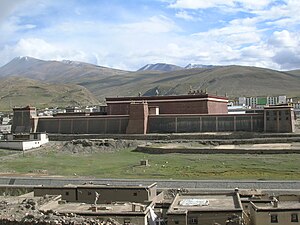Sakya Monastery
| Part of a series on |
| Tibetan Buddhism |
|---|
 |

Sakya Monastery, also known as dPal Sa skya or Pel Sakya ("White Earth" or "Pale Earth") is a Buddhist monastery situated 25 km southeast of a bridge which is about 127 km west of Shigatse on the road to Tingri in the Tibet Autonomous Region of China.
The seat of the Sakya or Sakyapa school of Tibetan Buddhism, it was founded in 1073 CE, by Konchok Gyelpo, originally a Nyingmapa monk of the powerful noble family of the Tsang. Its powerful abbots governed Tibet during the whole of the 13th century after the downfall of the kings until they were eclipsed by the rise of the new Gelukpa sect. They still have many followers in Tibet.
Its medieval Mongolian architecture is quite different from that of temples in Lhasa and Yarlong. The only surviving ancient building is the Lhakang Chempo or Sibgon Trulpa. Originally a cave in the mountainside, it was built in 1268 by Ponchen Sakya Sangpo in 1268 and restored in the 16th century. It contains some of the most magnificent surviving artwork in all of Tibet, which appears not to have been damaged in recent times.The Gompa grounds cover more than 18,000 square metres, while the huge main hall covers some 6,000 square metres.[1][2][3]

- "As to the great library of Sakya, it is on shelves along the walls of the great hall of the Lhakhang chen-po. There are preserved here many volumes written in gold letters; the pages are six feet long by eighteen inches in breadth. In the margin of each page are illuminations, and the first four volumes have in them pictures of the thousand Buddhas. These books are bound in iron. They were prepared under orders of the Emperor Kublai, and presented to Phag-pa on his second visit to Peking
- There is also preserved in this temple a conch shell with whorls turning from left to right [in Tibetan, Ya chyü dungkar ; and in Chinese Yu hsuan pai-lei], a present of Kublai to Phagpa. It is only blown by the lamas when the request is accompanied by a present of seven ounces of silver; but to blow it, or have it blown, is held to be an act of great merit."[4]
A huge library of as many as 84,000 scrolls were found sealed up in a wall 60 metres long and 10 metres high at Sakya (Ch: Sagya) Monastery in 2003. It is expected that most of them will prove to be Buddhist scriptures although they may well also include works of literature, and on history, philosophy, astronomy, mathematics and art. They are thought to have remained untouched for hundreds of years. They are being examined by the Tibetan Academy of Social Sciences.[5]
References
- ^ Dowman, Keith. The Power-Places of Central Tibet: The Pilgrim's Guide. Routledge & Kegan Paul, 1988, pp. 275-276. ISBN 0-7102-1370-0 (pbk)
- ^ Buckley, Michael and Strauss, Robert. Tibet - A Travel Survival Kit. Lonely Planet Publications. 1986, pp. 170-174. ISBN 0-908086-88-1.
- ^ Norbu, Thubten Jigme and Turnbull, Colin. Tibet: Its History, Religion and People. Chatto & Windus, 1969. Penguin Books reprint. 1987, p. 193.
- ^ Das, Sarat Chandra. Lhasa and Central Tibet, (1902), pp, 241-242. Reprint: Mehra Offset Press, Delhi. 1988.
- ^ http://news.xinhuanet.com/english/2003-11/14/content_1179489.htm
